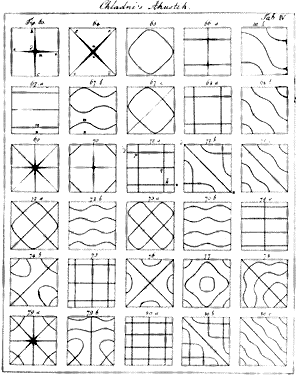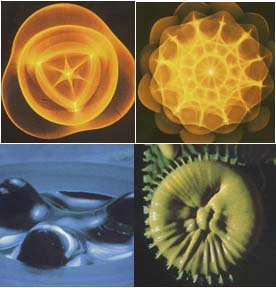
wisdom for your path
Sign up and receive our free newsletter with more inspiration and tips:
|
Sound, Words and Your Health Part 2 of "The Body's Symphony of Sound and Vibration" In our modern culture, where for many seeing is believing, how do we know that what sages and energy practitioners say about the power of sound is true? Is there evidence that vibration and sound can affect matter, interact with our molecules and stimulate healing? And if so, can we measure their effects? In the eighteenth-century, German scientist and musician Ernst Chladni, known as the father of acoustics, took a step toward answering these questions. He demonstrated, in simple, visual experiments, that sound affects matter. When he drew a violin bow around the edge of a plate covered with fine sand, the sand formed various geometric patterns, as shown below. 
Pictures of Sound: In the 1960s, Dr. Jenny placed sand, fluid and powders on metal plates, which he vibrated with a special frequency generator and a speaker. His experiments produced beautiful and intricate patterns that were unique to each individual vibration (see photographs below). Moreover, these varying patterns remained intact as long as the sound pulsed through the substance. If the sound stopped, the pattern collapsed. For many, these experiments show that sound can indeed alter form, that different frequencies produce different results, and that sound actually creates and maintains form. The photographs below are taken from Dr. Jenny's work in cymatics. Used with permission from the two-volume edition of Cymatics: A Study of Wave Phenomena, © 2001 MACROmedia, 219 Grant Road, Newmarket, NH 03857. www.cymaticsource.com.
Although best known for his stunning cymatic images, Dr. Jenny was also an artist and musician as well as a philosopher, historian and physical scientist. Perhaps most important, he was a serious student of nature’s ways with keen powers of observation. Whether it was the cycle of the seasons, a bird’s feathers, a rain drop, the formation of weather patterns, mountains or ocean waves—or even poetry, the periodic table, music or social systems—Dr. Jenny saw an underlying, unifying theme: wave patterns, produced by vibration. “Wherever we look, we can describe what we see in terms of periodicities and rhythmicities,” he wrote. “When nature creates anything it creates in this periodic style.”1 For him, everything reflected inherent patterns of vibration involving number, proportion and symmetry—what he called the “harmonic principle.” Dr. Jenny encouraged continuing research into the wave phenomenon. The purpose of such studies, he explained, was to “hear” the systems of Nature. “What we want to do is, as it were, to learn to ‘hear’ the process that blossoms in flowers, to ‘hear’ embryology in its manifestations and to apprehend the inwardness of the process,” he wrote.2 Our Cells Respond to Sound Two other researchers who have created visually compelling evidence of the power of sound are Japanese scientist Masaru Emoto and Fabien Maman. Maman, a French composer, acupuncturist and bioenergetician, and Helene Grimal, a biologist, experimented with both healthy and cancer cells to see how they would respond to the voice and to various instruments. In his book The Role of Music in the Twenty-First Century, Maman reports that among the dramatic effects of sound they captured in their photographs was the progressive destabilization of the structure of cancer cells. Maman says that when he played sounds that progressed up the musical scale, the cancer cells eventually exploded. Japanese scientist Dr. Masaru Emoto has shown the potent effects of sound by photographing water crystals. His work is published in his series of books Messages from Water and was featured in the movie What the Bleep Do We Know!? In his remarkable experiments, he played classical music and folk songs from Japan and other countries through speakers placed next to water samples. He then froze the water to make crystals and compared the crystalline structure of different samples. With each musical piece, the water sample formed different and beautifully geometric crystals. When he played heavy metal music, the water crystal’s basic hexagonal structure broke into pieces. Dr. Emoto’s work goes further still. He also measured the impact of words on the crystalline structure of water. The results of Dr. Emoto’s experiments match what psychologists, researchers and spiritual masters alike have shown—that the words we speak and the thoughts we think impact our well-being at all levels. In one experiment, Dr. Emoto and three hundred others assembled at the shore of a badly polluted lake in Japan and spoke aloud an affirmation of peace and gratitude. The water crystals changed from a cloudy and distorted image before the prayer to beautiful, geometric crystals after the prayer. Smaller groups of people have repeated this experiment at other lakes around the world with similar results, which Dr. Emoto has published in volume two of his Messages from Water. In another experiment, Dr. Emoto taped various words and phrases to jars of water. Afterward, he photographed the crystals formed when these water samples were frozen. Words or phrases such as thank you, love/appreciation and love thyself produced a variety of beautiful geometric forms. On the other hand, phrases such as you make me sick or you fool produced crystals that were disconnected or chaotic. The implications of these simple experiments are profound. Since our bodies are made up of 70 percent water, imagine how the sounds and vibrations that fill our external environment affect our internal environment, our very cells. Imagine how the words we speak—about ourselves and others—affect not only our own health but also the health and well-being of those in our lives. TIPS AND TOOLS First, take a moment and think about the sounds that surround you. • Think about the words you hear from others. Are there any that are consistently negative and that make you unhappy or drag you down? • The sounds of our own discontent can create discontent within others. Think about the words you speak that impact those in your sphere of influence. Where is there room for improvement? • Imagine your ideal sound environment. What kinds of sounds would you include? What sounds would you exclude? Although there may be sounds in your life that you cannot change, you always have some control over what you allow into your environment. Here are five tips and tools you can use to make better sound choices in your life. 1. Create a No-Fly Zone 2. Simplify Your Sound Space 3. Say No to Toxic Tones 4. Watch and Listen for Valuable Feedback 5. Surface Your Issues You owe it to yourself and those around you to confront the core issue. Try to step back and ask yourself: What is really bothering me? Objectively identify the issue by writing it down. If you can’t name what it is, start by writing down how you feel. Identifying on paper your true feelings or the unsettling circumstances in your life will help you get the real issues out into the open so you can take the next steps to resolution.
Notes 2. Ibid., p. 276 Copyright © 2005 Patricia R. Spadaro. All rights reserved
|
| From "Sound, Words and Your Health" |
|
|
Practical Spirituality with Patricia Spadaro
Copyright © 2004-. Patricia R. Spadaro. All Rights Reserved.
info@practicalspirituality.info


 When an ending is in the wings—whether a relationship, a job, a way of life—let it go and let yourself fly.>>
When an ending is in the wings—whether a relationship, a job, a way of life—let it go and let yourself fly.>>